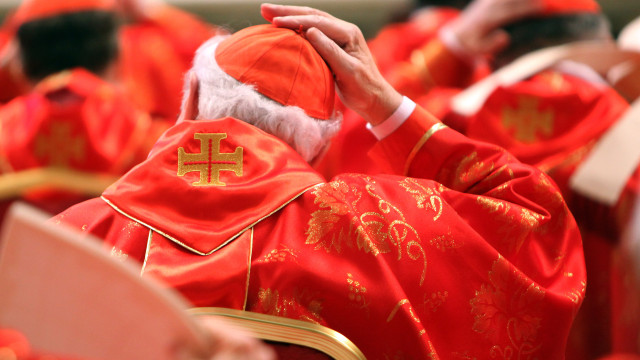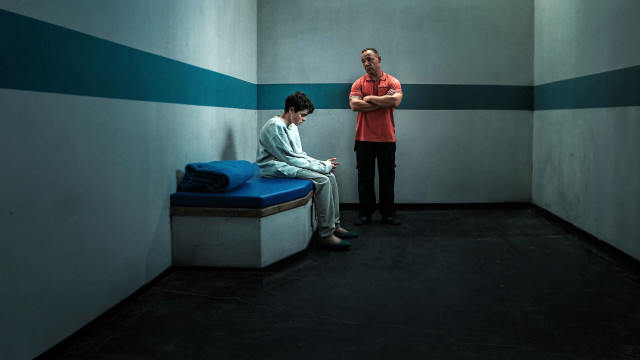





























See Also
See Again
© Getty Images
0 / 30 Fotos
There are different crowns
- The crown worn during the coronation is called the St. Edward's Crown, and it's only used for that purpose. The newly crowned monarch wears a different one when leaving Westminster Abbey.
© Getty Images
1 / 30 Fotos
Crown number two
- The second crown is known as the Imperial State Crown, and it's also the one worn on state occasions, such as the yearly Opening of Parliament.
© Getty Images
2 / 30 Fotos
Some of the early Crown Jewels were lost
- It's believed that King John lost an early collection of the jewels in 1216, while traveling across an estuary known as the Wash.
© Getty Images
3 / 30 Fotos
Lost forever
- There have been many attempts throughout the centuries to find the lost jewels. But all the efforts have been without success to date.
© Getty Images
4 / 30 Fotos
The oldest surviving piece of the Crown Jewels is the coronation spoon
- Estimated to be from the 12th century, the coronation spoon is the oldest of the Crown Jewels.
© Getty Images
5 / 30 Fotos
During the coronation
- During the coronation ceremony, the spoon is filled with holy oil, which has been consecrated in Jerusalem. The oil is then used to anoint the monarch.
© Getty Images
6 / 30 Fotos
Oliver Cromwell had many of the Crown Jewels destroyed
- Following the English Civil War (1642-1651) and the execution of Charles I, the monarchy was abolished, and Oliver Cromwell became Lord Protector of the Commonwealth.
© Getty Images
7 / 30 Fotos
The fate of the jewels
- Cromwell ordered the Crown Jewels to be melted down or sold. The coronation spoon survived because its buyer returned it after the restoration of the monarchy in 1660.
© Getty Images
8 / 30 Fotos
The majority of the current Crown Jewels were created after the restoration of the monarchy
- Because only a few items had survived, a new set of Crown Jewels were needed following the monarchy's restoration.
© Getty Images
9 / 30 Fotos
The new Crown Jewels
- In 1660, Charles II ordered the creation of new regalia based on the originals, which were used at his coronation the following year. The majority of the Crown Jewels used today are from this time.
© Getty Images
10 / 30 Fotos
The Scottish Crown Jewels were hidden for safety following the destruction of the English ones
- The destruction of the English Crown Jewels sparked fear among the Scots. So they hid their Crown Jewels around Scotland until the English monarchy was restored.
© Getty Images
11 / 30 Fotos
The Scottish Crown Jewels were hidden for safety following the destruction of the English ones
- The Honours of Scotland were eventually returned to Edinburgh Castle, where they were locked away after England and Scotland came together as the United Kingdom of Great Britain in 1707. Sir Walter Scott rediscovered them at the castle in 1818.
© Getty Images
12 / 30 Fotos
There was an attempt to steal the Crown Jewels in 1671
- Just a decade after they were created, the Crown Jewels were almost stolen. A wanted man at the time, Thomas Blood and his accomplices managed to seize St. Edward’s Crown, the Sceptre with Cross, and the Sovereign’s Orb before getting caught.
© Getty Images
13 / 30 Fotos
No punishment for Blood
- Surprisingly, instead of sending Blood (pictured) to prison, King Charles II pardoned him and granted him land in Ireland.
© Getty Images
14 / 30 Fotos
The largest clear-cut diamond is part of the Crown Jewels
- In 1905, the 3,106-carat Cullinan Diamond, the largest uncut diamond ever found, was unearthed in today's South Africa. The two largest clear-cut diamonds from the gemstone are part of the Crown Jewels.
© Getty Images
15 / 30 Fotos
Cullinan I
- The largest, Cullinan I, forms part of the Sovereign’s Sceptre with Cross.
© Getty Images
16 / 30 Fotos
Cullinan II
- The second largest, Cullinan II, is embedded in the Imperial State Crown.
© Getty Images
17 / 30 Fotos
The controversial Koh-i-Noor diamond
- Known as the Koh-i-Noor, the famous diamond has been part of the crowns worn by many women in the royal family.
© Getty Images
18 / 30 Fotos
Origins of the Koh-i-Noor
- The original diamond belonged to the Sikh kingdom, but the British East India Company forced them to surrender it in 1849 during the Second Anglo-Sikh War.
© Getty Images
19 / 30 Fotos
In the monarchy's hands
- Lord Dalhousie, the Governor-General of India, then gave the Koh-i-Noor diamond to the monarchy.
© Getty Images
20 / 30 Fotos
Koh-i-Noor as a Crown Jewel
- After Prince Albert had it recut, his wife, Queen Victoria, wore the Koh-i-Noor as a brooch. The stone later became part of the Crown Jewels.
© Public Domain
21 / 30 Fotos
Still a controversial diamond
- For several decades, many countries have claimed ownership of the Koh-i-Noor, but the British government has refused to return it.
© Getty Images
22 / 30 Fotos
The most recent item joined the collection in 1953
- The latest addition to the collection is a set of 22-karat gold armills, which were gifted to Queen Elizabeth II for her 1953 coronation.
© Getty Images
23 / 30 Fotos
The Crown Jewels during World War II
- With the threat of both bombings and a potential German invasion of Britain, the Crown Jewels had to be kept safe during WWII.
© Getty Images
24 / 30 Fotos
An unlikely hiding spot
- This led to gemstones from the Crown Jewels being hidden inside a biscuit tin, which was buried under Windsor Castle. They remained there for the duration of the war.
© Getty Images
25 / 30 Fotos
There are many Crown Jewels
- The Crown Jewels collectively refer to 23,578 precious and semi-precious stones owned by King Charles III.
© Getty Images
26 / 30 Fotos
They're found on a total of 140 items
- From robes to swords, and, of course, crowns, the Crown Jewels are embedded in over 140 items.
© Getty Images
27 / 30 Fotos
They used to be kept in Westminster Abbey
- The Crown Jewels were previously kept in Westminster Abbey, but a number of attempted thefts saw them transferred to the Tower of London in the 14th century.
© Getty Images
28 / 30 Fotos
Technically, they're not worth anything
- Seeing as the Crown Jewels have never been put on sale, and probably never will, it’s practically impossible to accurately value them. Sources: (Mental Floss) (Culture Trip) See also: Treasures of the Royal Collection
© Getty Images
29 / 30 Fotos
© Getty Images
0 / 30 Fotos
There are different crowns
- The crown worn during the coronation is called the St. Edward's Crown, and it's only used for that purpose. The newly crowned monarch wears a different one when leaving Westminster Abbey.
© Getty Images
1 / 30 Fotos
Crown number two
- The second crown is known as the Imperial State Crown, and it's also the one worn on state occasions, such as the yearly Opening of Parliament.
© Getty Images
2 / 30 Fotos
Some of the early Crown Jewels were lost
- It's believed that King John lost an early collection of the jewels in 1216, while traveling across an estuary known as the Wash.
© Getty Images
3 / 30 Fotos
Lost forever
- There have been many attempts throughout the centuries to find the lost jewels. But all the efforts have been without success to date.
© Getty Images
4 / 30 Fotos
The oldest surviving piece of the Crown Jewels is the coronation spoon
- Estimated to be from the 12th century, the coronation spoon is the oldest of the Crown Jewels.
© Getty Images
5 / 30 Fotos
During the coronation
- During the coronation ceremony, the spoon is filled with holy oil, which has been consecrated in Jerusalem. The oil is then used to anoint the monarch.
© Getty Images
6 / 30 Fotos
Oliver Cromwell had many of the Crown Jewels destroyed
- Following the English Civil War (1642-1651) and the execution of Charles I, the monarchy was abolished, and Oliver Cromwell became Lord Protector of the Commonwealth.
© Getty Images
7 / 30 Fotos
The fate of the jewels
- Cromwell ordered the Crown Jewels to be melted down or sold. The coronation spoon survived because its buyer returned it after the restoration of the monarchy in 1660.
© Getty Images
8 / 30 Fotos
The majority of the current Crown Jewels were created after the restoration of the monarchy
- Because only a few items had survived, a new set of Crown Jewels were needed following the monarchy's restoration.
© Getty Images
9 / 30 Fotos
The new Crown Jewels
- In 1660, Charles II ordered the creation of new regalia based on the originals, which were used at his coronation the following year. The majority of the Crown Jewels used today are from this time.
© Getty Images
10 / 30 Fotos
The Scottish Crown Jewels were hidden for safety following the destruction of the English ones
- The destruction of the English Crown Jewels sparked fear among the Scots. So they hid their Crown Jewels around Scotland until the English monarchy was restored.
© Getty Images
11 / 30 Fotos
The Scottish Crown Jewels were hidden for safety following the destruction of the English ones
- The Honours of Scotland were eventually returned to Edinburgh Castle, where they were locked away after England and Scotland came together as the United Kingdom of Great Britain in 1707. Sir Walter Scott rediscovered them at the castle in 1818.
© Getty Images
12 / 30 Fotos
There was an attempt to steal the Crown Jewels in 1671
- Just a decade after they were created, the Crown Jewels were almost stolen. A wanted man at the time, Thomas Blood and his accomplices managed to seize St. Edward’s Crown, the Sceptre with Cross, and the Sovereign’s Orb before getting caught.
© Getty Images
13 / 30 Fotos
No punishment for Blood
- Surprisingly, instead of sending Blood (pictured) to prison, King Charles II pardoned him and granted him land in Ireland.
© Getty Images
14 / 30 Fotos
The largest clear-cut diamond is part of the Crown Jewels
- In 1905, the 3,106-carat Cullinan Diamond, the largest uncut diamond ever found, was unearthed in today's South Africa. The two largest clear-cut diamonds from the gemstone are part of the Crown Jewels.
© Getty Images
15 / 30 Fotos
Cullinan I
- The largest, Cullinan I, forms part of the Sovereign’s Sceptre with Cross.
© Getty Images
16 / 30 Fotos
Cullinan II
- The second largest, Cullinan II, is embedded in the Imperial State Crown.
© Getty Images
17 / 30 Fotos
The controversial Koh-i-Noor diamond
- Known as the Koh-i-Noor, the famous diamond has been part of the crowns worn by many women in the royal family.
© Getty Images
18 / 30 Fotos
Origins of the Koh-i-Noor
- The original diamond belonged to the Sikh kingdom, but the British East India Company forced them to surrender it in 1849 during the Second Anglo-Sikh War.
© Getty Images
19 / 30 Fotos
In the monarchy's hands
- Lord Dalhousie, the Governor-General of India, then gave the Koh-i-Noor diamond to the monarchy.
© Getty Images
20 / 30 Fotos
Koh-i-Noor as a Crown Jewel
- After Prince Albert had it recut, his wife, Queen Victoria, wore the Koh-i-Noor as a brooch. The stone later became part of the Crown Jewels.
© Public Domain
21 / 30 Fotos
Still a controversial diamond
- For several decades, many countries have claimed ownership of the Koh-i-Noor, but the British government has refused to return it.
© Getty Images
22 / 30 Fotos
The most recent item joined the collection in 1953
- The latest addition to the collection is a set of 22-karat gold armills, which were gifted to Queen Elizabeth II for her 1953 coronation.
© Getty Images
23 / 30 Fotos
The Crown Jewels during World War II
- With the threat of both bombings and a potential German invasion of Britain, the Crown Jewels had to be kept safe during WWII.
© Getty Images
24 / 30 Fotos
An unlikely hiding spot
- This led to gemstones from the Crown Jewels being hidden inside a biscuit tin, which was buried under Windsor Castle. They remained there for the duration of the war.
© Getty Images
25 / 30 Fotos
There are many Crown Jewels
- The Crown Jewels collectively refer to 23,578 precious and semi-precious stones owned by King Charles III.
© Getty Images
26 / 30 Fotos
They're found on a total of 140 items
- From robes to swords, and, of course, crowns, the Crown Jewels are embedded in over 140 items.
© Getty Images
27 / 30 Fotos
They used to be kept in Westminster Abbey
- The Crown Jewels were previously kept in Westminster Abbey, but a number of attempted thefts saw them transferred to the Tower of London in the 14th century.
© Getty Images
28 / 30 Fotos
Technically, they're not worth anything
- Seeing as the Crown Jewels have never been put on sale, and probably never will, it’s practically impossible to accurately value them. Sources: (Mental Floss) (Culture Trip) See also: Treasures of the Royal Collection
© Getty Images
29 / 30 Fotos
Surprising facts about the Crown Jewels
The Crown Jewels embody all the excess and extravagance of the British monarchy
© Getty Images
The epitome of wealth and opulence, the majority of the precious Crown Jewels date back centuries. And, of course, they're filled with both history and controversy. From an attempted theft to its World War II hiding spot and colonial disputes, they've been through more than you'd imagine!
Intrigued? Click through this gallery to discover more about this collection of ceremonial objects and royal regalia.
RECOMMENDED FOR YOU




































MOST READ
- Last Hour
- Last Day
- Last Week








